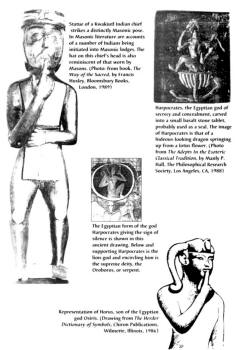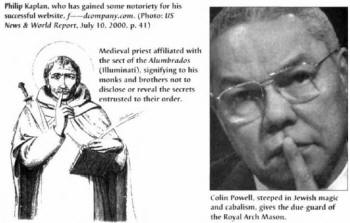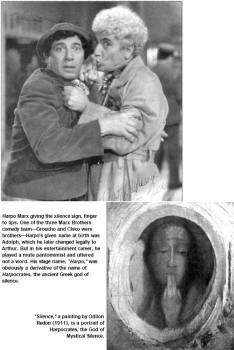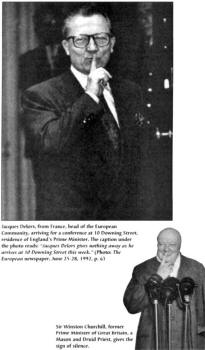|
FOURTEEN
"Silence, Slaves, or We'll Cut Your Throat From Ear to Ear!"
...binding myself under no less penalty than that of having my
throat cut
across...
— Oath of Freemasonry Entered Apprentice Degree (1°)
But above all things, my brethren, swear not, neither by heaven,
neither by the
earth, neither by any other oath...
— James 5:12
In every ritual degree of Freemasonry and in all the most important
ceremonial rituals and initiations of elite orders, the candidate is
required to take an oath and is warned of the hideous and grotesque
penalty that
awaits him if he dares ever to reveal any of the group's innermost
secrets.1
For example, in the very first degree oath of Freemasonry,
the candidate declares:
...binding myself under no less penalty than that of having my
throat cut across, my tongue torn out by its roots, and my body
buried in the rough sands of the sea, at low-water mark, where the
tide ebbs and flows twice in twenty-four hours, should I ever
knowingly violate this my Entered Apprentice obligation.
Second degree Masons recite the following heinous oath:
...binding myself under no less penalty than that of having my
breast torn open, my heart plucked out, and placed on the highest
pinnacle of the temple there to be devoured by the vultures of the
air, should I ever knowingly violate the Fellow Craft obligation.
The third degree oath proclaims:
...binding myself under no less penalty than that of having my body
severed in two, my bowels taken from thence and burned to ashes, the
ashes scattered before the four winds of heaven, that no more
remembrance might be had of so vile and wicked a wretch as I would
be, should I ever, knowingly, violate this my Master Mason's
obligation.
That's not all.
In the 4th degree, Mark Master of the York Rite, the
candidate performs a ritual which symbolizes having his "ear smitten
off" if he reveals the order's secrets.
And for the 5th degree, Past
Master, the hapless candidate agrees as follows:
...binding myself under no less penalty than (in addition to all my
former penalties) to have my tongue split from tip to root, that I
might thereafter be unable to pronounce the word.
The sixth degree (Most Excellent Master) of the York Rite continues
with the horrific penalties:
...binding myself under no less penalty than to have my breast torn
open, and my heart and vitals taken from thence, and exposed to rot
on the dunghill.
The Sign of Silence
Illuminists have a sign to be used to remind associates when it is
needful to stonewall or to shut up about a matter. In the York Rite
initiation for the Royal Master's Degree, this sign, called the
Due-guard, "is made by placing the forefinger of the right hand upon
the lips."2
Richardson's Monitor of Freemasonry remarks that this
sign "is a caution to a companion when you wish him to keep
silent."3
In the ritual degree ceremony of the Secret Master, the candidate
places two fingers to his lip and is told that the obligation he is
taking "enjoins secrecy and to
obey the orders and decrees of the Council of Princes of Jerusalem,
under penalties of all former degrees."4
For the fifth degree (Past
Master) the penal dueguard sign is the placement of the thumb to
one's mouth, again indicating the warning to keep silent.

Richardson's Monitor of Freemasonry (pp. 142-143) provides these
bloody reminders of the horrible penalties that await the Mason or
other elitist who divulges secrets of the Order. "Silence, Slaves"
is certainly the catchword for the submissive servants of Satan's
earthly elite corps of leaders.
A Softening of Penalties?
Freemasonry and many other secret societies have been under siege in
recent years as the author of Codex Magica and a number of other
courageous men have boldly come forward exposing the frightening,
cold and bloody oaths taken by millions of Masons around the globe.
As a consequence, as I understand it, the leadership of the Lodge
and other groups has more recently begun to "soften the edges," so
to speak and to eliminate some of the more egregious and ghastly
phrases and words used in the rituals.
In June 2001, according to The Scottish Rite Journal, C. Fred Kleinknecht, Sovereign Grand Commander, 33°, the reigning potentate
of Freemasonry, presented copies of the Revised Standard Pike Ritual
to his subordinate Sovereign Grand Commanders.5
Kleinknecht
explained to his lieutenants that this new guide provides "modified
versions" of the seventh and twenty-seventh degrees which were
originally created by Albert Pike, their much revered nineteenth
century "Illustrious Sovereign Grand Master."6

One can assume that
to appease its critics, further editions of the ritual will water
down the most grievous of the penalties.
Other ways, however, will undoubtedly be found to motivate the
membership to keep the secrets, including banishment from elite
status and possibly even the periodic assassination of disciples who
stray and who recklessly disregard the dictate to retain secrecy.
Still it is of interest that the Masonic elite are embarrassed over
being outed for their hideous oaths. What's more, in the Mormon
Church (LDS), the penalty portions of the Masonic-oriented rituals
celebrated in the Temple also have recently been watered down
somewhat.
Pagan Origins of the Sign of Silence
The Masonic practice of signs warning of frightening penalties for
breaking silence most definitely is of pagan origins. In Greece,
Rome, Babylon, and Egypt, those who had loose lips often paid with
their lives and fortunes, so sacred and guarded were the secrets of
the Mystery Religions.
The Egyptians and Romans even worshipped a God of silence,
Harpocrates, a form of the solar deity. Harpocrates was often
pictured sitting on his mother's lap, suckling at her breast. Later,
the Catholic Church adopted similar images in the veneration of Mary
with child. Sometimes Harpocrates was pictured naked or with horns
on his head, symbols of power. He often sat on a Lotus flower. The
Lotus is a sexual symbol of the female vagina.7
In the active days of Benjamin Franklin and our nation's founders,
their secret society counterparts in Great Britain made use of the
God Harpocrates. Sir Francis Dashwood, instrumental in the British
operation of the Illuminati, recruited nobility for his Hell-Fire
Club, a secret group based on magic, satanism, and sex.
Numerous
harlots—and sometimes newly deflowered virgins—were used by Dashwood and his occultic, jolly men. On club premises, the
members erected a statue of Harpocrates, depicting him solemnly
holding a finger to his mouth to
remind the frolicking members of the Hell-Fire Club that, "What
happens here, stays here."8

Rome also had the Mystery Goddess Angerona. Her statue showed
Angerona as a beautiful woman holding a finger to her mouth, "the
emblem of secrecy and mystery."9
Angerona watched over the sexual
promiscuity goings-on at various orgies connected with the festivals
of the solstices and the changing of the seasons.
The Mystery Religions of the Romans and other peoples especially
needed the utmost secrecy because, during the higher initiations,
the unspoken names of the hidden or unknown God, or Gods, was often
revealed. As the Christians gained in numbers and influence, they
began to properly understand that these names were actually synonyms
for Satan, Lucifer, the Devil. Great effort was therefore taken by
pagans to obscure or prevent the unmasking of this satanic
connection.10
An interesting side-note: As a child watching TV in the early days
(1950s), one of the most popular programs was a game show hosted by
Jewish comedian Groucho Marx. Groucho had a brother, Harpo Marx, who
was also a comedian and starred in numerous TV programs and in
movies. Harpo always played the cherubic character of a mute young
boy, with blond hair in curls. In other words, Harpo was cast in the
image of Harpocrates, God of silence and secrecy, also known as
Horus the child.

 

Lawrence Summers, President of Harvard University and former
Secretary of the Treasury under President Bill Clinton. (Photo: Time
magazine, May 24, 1999)
 
Harpo Marx giving the silence sign, finger to lips. One of the three
Marx Brothers comedy team—Groucho and Chico were brothers—Harpo's
given name at birth was Adolph, which he later changed legally to
Arthur. But in his entertainment career, he played a mute
pantomimist and uttered not a word. His stage name, "Harpo," was
obviously a derivative of the name of Harpocrates, the ancient Greek
God of silence.
"Silence," a painting by Odilon Redon (1911), is a portrait of
Harpocrates, the God of Mystical Silence.
Back to
Contents
|








